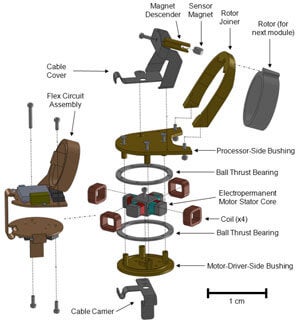Having been modeled after a variety of organisms (or their parts), robots come in all shapes and sizes but researchers at MIT now report that they’ve designed their robots after the very structures that make up living cells: proteins. Dubbed the Millimeter-Scale Motorized Protein or Milli-Motein, the tiny robots are able to change from extended chains to various 3D folded shapes in seconds.
But the really impressive feature is that the robots keep their shape even after power has been removed, thanks to a new kind of motor the team developed.
Each chain consists of 1-cm units that connect together, just as amino acids link up to make a protein, with a continuous flex circuit that controls power and communication to the device. Currently, the motor in each segment is able to lift only one other segment, but the researchers are already working on extending this to two segments.
The video put out by MIT shows how the snake-like robot can adopt and hold different configurations:
Developed by the team, the Electropermanent Wobble Stepper Motor, as its called, is designed using a combination of electromagnetic and electropermanent magnets. Applying current one way or the other around the rotor switches the magnetization of the electromagnetic components, causing the direction of the motor to change. When power is turned off , the electropermanent magnets maintain the configuration of the chain.

As a prototype, the team acknowledges that this is far from being usable as a universal material, but with an improved design (both in hardware and software), lighter and cheaper materials, and more degrees of freedom, the goal can be realized. Additionally, it is believed that the Milli-Moteins could be scaled down smaller than a few inches in length, possibly be a factor of 10, and production scaled up even with more complex components.
The research, presented recently at the 2012 Intelligent Robots and Systems conference, was conducted at the Center for Bits and Atoms and funded by a DARPA grant.
The project is an effort to realize programmable matter, that is, materials that can change into various objects on command. Many of the structures in a living cell are made from polypeptide chains that fold into discrete structures we call proteins. Scientists are interested in how these chains fold because of the plethora of structures that can be obtained. If analogous macroscale chains could be manufactured and programmed, then one could simply instruct the material to turn into anything.
For example, a Swiss army knife would transform into the tool desired rather than have each tool extend from its base.
Programmable matter is the kind of idea that has taken researchers to the very frontier of science, electronics, and engineering. In light of the plethora of structures found in nature that are constructed from protein chains, it’s definitely a worthy goal to aspire to.




